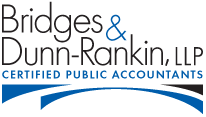Quarterly Estimated Tax Payments
By Kenneth H. Bridges, CPA, PFS June 2023
Quarterly estimated tax payments. Not exactly the sexiest of topics, but one we get a lot of questions about and one that creates a fire drill for our tax professionals the first two weeks of every January, April, June, and September.
Federal law requires that income tax be paid in at least quarterly over the course of the year. State rules vary, but are generally similar to (although often harsher than) the Federal rules, which we will summarize here.
Under Federal rules, you can avoid a penalty for underpayment of estimated tax (UET) by paying in each quarter at least the lesser of:
- ¼ of 90% of your actual tax liability for the year (what we refer to as the “crystal ball method”, since you are trying to forecast for the year, but the penalty is based on actual with the benefit of hindsight);
- ¼ of 100% (110% if your income was over $150,000) of your tax for the immediately preceding year (known as the “prior year tax liability safe harbor”); or
- ¼ of your tax liability as computed by annualizing your actual taxable income year-to-date through the end of the month immediately preceding the payment date and computing the applicable tax thereon (known as the “annualized income installment method”).
You can switch methods from quarter to quarter (going with the method which results in the least required amount); so long as you catch up cumulatively on the chosen method. You can pay any remaining balance due by April 15 of the following year, penalty free.
Withholding on W-2 is income is deemed to have occurred ratably throughout the year, unless you elect to prove otherwise.
The required payment dates for individuals are April 15, June 15, September 15 and January 15, for 1st, 2nd, 3rd and 4th quarters respectively. These dates, obviously, do not exactly align with the calendar quarters to which they relate (July 15 and October 15 would seem more logical dates for Q2 and Q3), and can result in some confusion and, occasionally, illogical results. For corporations, the required dates are the 4th, 6th, 9th and 12th months of the tax year (i.e., for a calendar year corporation, the same as that for individuals, other than Q4).
Unlike many tax penalties, the UET penalty is not a cliff. It is computed on a daily basis like interest, with the rate being tied to short-term interest rates (plus 3 percentage points, and with rounding, such that the current UET penalty rate is 7% per annum). So, there is no need to panic if you make your quarterly payment on the 16th (or 17th or 18th) rather than the 15th; as the penalty amount, if any, for being a few days late is likely to be relatively small. But lengthy delays in making the payments can obviously result in a meaningful penalty.
The penalty is computed on Form 2210 (2220 for corporations) when you file your income tax return for the year. When you file your return, the IRS system will first automatically check to see if you paid in each quarter at least 22.5% of your tax for the year. If so, no penalty applies. The IRS system will next check to see if you paid in each quarter at least 25% (27.5% if income was over $150,000) of your tax for the preceding year. If so, then no penalty applies. Absent meeting one of these two tests, you must attach Form 2210 (or 2220) to your return if you want to show that you avoid or minimize the penalty by computing your required payment based on the annualized income installment method. Similarly, you must attach Form 2210 if you want to show IRS that your W-2 withholding was frontloaded into the year, rather than having been ratable throughout the year.
Because W-2 withholding is deemed to have occurred ratably throughout the year (unless you choose to show otherwise), having a significant amount of tax withheld on a late-year bonus can be a way to catch up and avoid a penalty for earlier quarters.
Large corporations (those with taxable income of $1,000,000 or more for any of the preceding 3 years), corporations for which the preceding year tax return was for less than 12 months, and corporations for which the preceding year return did not reflect a tax liability cannot rely on the prior year tax liability safe harbor.
It should be noted that under IRC 7203, criminal penalties can apply for a willful failure to pay estimated tax.
Kenneth H. Bridges, CPA, PFS is a partner with Bridges & Dunn-Rankin, LLP, an Atlanta-based CPA firm.
This article is presented for educational and informational purposes only, and is not intended to constitute legal, tax or accounting advice. The article provides only a very general summary of complex rules. For advice on how these rules may apply to your specific situation, contact a professional tax advisor.
